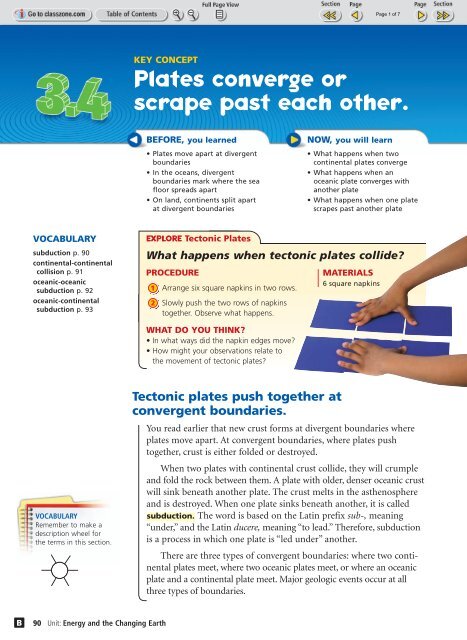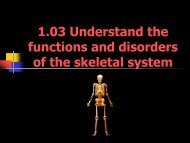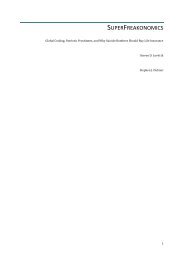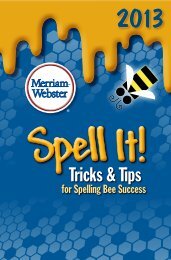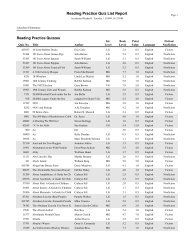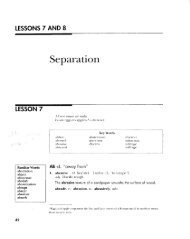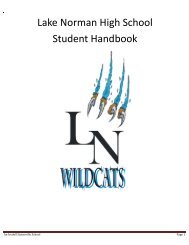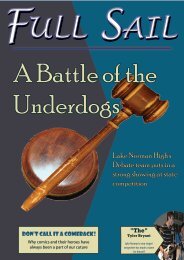Plates converge or scrape past each other.
Plates converge or scrape past each other.
Plates converge or scrape past each other.
You also want an ePaper? Increase the reach of your titles
YUMPU automatically turns print PDFs into web optimized ePapers that Google loves.
KEY CONCEPT<br />
<strong>Plates</strong> <strong>converge</strong> <strong>or</strong><br />
<strong>scrape</strong> <strong>past</strong> <strong>each</strong> <strong>other</strong>.<br />
BEFORE, you learned<br />
•<strong>Plates</strong> move apart at divergent<br />
boundaries<br />
•In the oceans, divergent<br />
boundaries mark where the sea<br />
flo<strong>or</strong> spreads apart<br />
• On land, continents split apart<br />
at divergent boundaries<br />
NOW, you will learn<br />
•What happens when two<br />
continental plates <strong>converge</strong><br />
• What happens when an<br />
oceanic plate <strong>converge</strong>s with<br />
an<strong>other</strong> plate<br />
• What happens when one plate<br />
<strong>scrape</strong>s <strong>past</strong> an<strong>other</strong> plate<br />
VOCABULARY<br />
subduction p. 90<br />
continental-continental<br />
collision p. 91<br />
oceanic-oceanic<br />
subduction p. 92<br />
oceanic-continental<br />
subduction p. 93<br />
EXPLORE Tectonic <strong>Plates</strong><br />
What happens when tectonic plates collide?<br />
PROCEDURE<br />
1<br />
2<br />
Arrange six square napkins in two rows.<br />
Slowly push the two rows of napkins<br />
together. Observe what happens.<br />
MATERIALS<br />
6 square napkins<br />
WHAT DO YOU THINK?<br />
•In what ways did the napkin edges move?<br />
• How might your observations relate to<br />
the movement of tectonic plates?<br />
VOCABULARY<br />
Remember to make a<br />
description wheel f<strong>or</strong><br />
the terms in this section.<br />
Tectonic plates push together at<br />
<strong>converge</strong>nt boundaries.<br />
You read earlier that new crust f<strong>or</strong>ms at divergent boundaries where<br />
plates move apart. At <strong>converge</strong>nt boundaries, where plates push<br />
together, crust is either folded <strong>or</strong> destroyed.<br />
When two plates with continental crust collide, they will crumple<br />
and fold the rock between them. A plate with older, denser oceanic crust<br />
will sink beneath an<strong>other</strong> plate. The crust melts in the asthenosphere<br />
and is destroyed. When one plate sinks beneath an<strong>other</strong>, it is called<br />
subduction. The w<strong>or</strong>d is based on the Latin prefix sub-, meaning<br />
“under,” and the Latin ducere, meaning “to lead.” Theref<strong>or</strong>e, subduction<br />
is a process in which one plate is “led under” an<strong>other</strong>.<br />
There are three types of <strong>converge</strong>nt boundaries: where two continental<br />
plates meet, where two oceanic plates meet, <strong>or</strong> where an oceanic<br />
plate and a continental plate meet. Maj<strong>or</strong> geologic events occur at all<br />
three types of boundaries.<br />
B<br />
90 Unit: Energy and the Changing Earth
Continental-Continental Collision<br />
A continental-continental collision occurs where two plates carrying<br />
continental crust push together. Because both crusts are the same<br />
density, neither plate can sink beneath the <strong>other</strong>. If the plates keep<br />
moving, their edges crumple and fold, as in the diagram below.<br />
You can see the same effect if you put two blocks<br />
of clay on a table and push them together. If you<br />
push hard enough, one <strong>or</strong> both of the blocks will<br />
buckle. One cannot sink under the <strong>other</strong>, so the clay<br />
folds under the pressure.<br />
In some cases, the folded crust can be pushed<br />
up high enough to f<strong>or</strong>m mountains. Some of the<br />
w<strong>or</strong>ld’s largest mountains appear along continentcontinent<br />
boundaries. F<strong>or</strong> instance, the European<br />
Alps, shown in the photograph at right, are found<br />
where the African and European plates are colliding.<br />
The tallest mountains in the w<strong>or</strong>ld, the Himalayas, first f<strong>or</strong>med when<br />
the Indian Plate began colliding with the European Plate.<br />
The Himalayas and the Alps are still f<strong>or</strong>ming today. As long as<br />
the plates keep moving, these mountains will keep rising higher.<br />
Alps<br />
The European Alps began<br />
rising nearly 40 million<br />
years ago as a section of<br />
the African Plate collided<br />
with the European Plate.<br />
Check Your Reading<br />
Explain how colliding plates f<strong>or</strong>m mountain ranges.<br />
Convergent Boundary—Collision<br />
Rocks crumple and fold to f<strong>or</strong>m mountains.<br />
Why can neither plate sink under the <strong>other</strong>?<br />
Chapter 3: Plate Tectonics 91<br />
B
Oceanic-Oceanic Subduction<br />
An oceanic-oceanic subduction occurs where one plate with oceanic<br />
crust sinks, <strong>or</strong> subducts, under an<strong>other</strong> plate with oceanic crust.<br />
The older plate sinks because it is colder and denser than the younger<br />
plate. When the older crust r<strong>each</strong>es the asthenosphere, it melts in the<br />
intense heat. Two main features f<strong>or</strong>m at oceanic-oceanic subductions:<br />
deep-ocean trenches and island arcs.<br />
Deep-Ocean Trenches These trenches are like deep canyons that f<strong>or</strong>m<br />
in the ocean flo<strong>or</strong> as a plate sinks. Most deep-ocean trenches are<br />
found in the Pacific Ocean. F<strong>or</strong> example, at the Mariana Trench, the<br />
Pacific Plate is sinking under the Philippine Plate. This trench is the<br />
deepest place in the w<strong>or</strong>ld’s oceans, extending nearly 11,000 meters<br />
(36,000 ft) into the sea flo<strong>or</strong>.<br />
Island Arcs There are chains of volcanic islands that f<strong>or</strong>m on the top<br />
plate, parallel to a deep-ocean trench. As oceanic crust of the sinking<br />
plate melts, magma rises through the top plate. Over time, the flows<br />
build up a series of islands. Island arcs include the Philippine Islands,<br />
the Aleutian Islands of Alaska, and the islands of Japan.<br />
Convergent Boundaries—Subduction<br />
Sinking plates f<strong>or</strong>m deep-ocean trenches, island arcs,<br />
and coastal mountains.<br />
Volcanic islands f<strong>or</strong>m<br />
on the top plate.<br />
Coastal mountains<br />
and volcanoes f<strong>or</strong>m<br />
on the top plate.<br />
A trench f<strong>or</strong>ms where<br />
the denser oceanic<br />
plate sinks.<br />
A trench f<strong>or</strong>ms where<br />
the oceanic plate sinks.<br />
Oceanic-oceanic<br />
subduction<br />
Oceanic-continental<br />
subduction<br />
Where in the diagram is crust being f<strong>or</strong>med? Where is<br />
crust being destroyed?<br />
B<br />
92 Unit: Energy and the Changing Earth
Oceanic-Continental Subduction<br />
An oceanic-continental subduction occurs when ocean crust sinks<br />
under continental crust, as shown in the diagram on page 92. The<br />
oceanic crust sinks because it is colder and denser than the continental<br />
crust. At these sites, deep-ocean trenches also f<strong>or</strong>m, along with<br />
coastal mountains.<br />
Deep-Ocean Trenches Some of the w<strong>or</strong>ld’s youngest trenches are in<br />
the eastern Pacific Ocean. Here, f<strong>or</strong> example, the Pacific Plate is sinking<br />
under the N<strong>or</strong>th American Plate. As the oceanic crust moves, it often<br />
causes underwater earthquakes.<br />
Coastal Mountains As oceanic crust sinks under a continent, the<br />
continental crust buckles to f<strong>or</strong>m a range of mountains. These mountains,<br />
like island arcs, parallel a deep-ocean trench. As the diagram on<br />
page 92 shows, some of these mountains are volcanoes, which f<strong>or</strong>m as<br />
melted oceanic crust rises through the top plate.<br />
The Cascade Mountains in Oregon and Washington are an example<br />
of coastal mountains. They began f<strong>or</strong>ming as the Juan de Fuca Plate<br />
began sinking under the N<strong>or</strong>th American Plate. Some of these peaks,<br />
such as Mount St. Helens in Washington, are active volcanoes.<br />
VISUALIZATION<br />
CLASSZONE.COM<br />
Expl<strong>or</strong>e what happens<br />
along plate boundaries.<br />
Check Your Reading<br />
Why do deep-ocean trenches f<strong>or</strong>m at both types of subduction?<br />
Convergent Boundaries<br />
How can you model converging plates?<br />
Tectonic plates move so slowly and are so large that it may be hard to visualize<br />
exactly how they move. Use what you know to design models showing how<br />
converging plates collide and subduct.<br />
PROCEDURE<br />
1<br />
2<br />
Design your models using the materials listed.<br />
You can use the diagrams on pages 91–92 as a guide.<br />
Add m<strong>or</strong>e clay to your models if you need it.<br />
SKILL FOCUS<br />
Designing models<br />
MATERIALS<br />
•clay in three <strong>or</strong><br />
m<strong>or</strong>e col<strong>or</strong>s<br />
• poster board<br />
• marker pens<br />
TIME<br />
30 minutes<br />
WHAT DO YOU THINK?<br />
• Describe how your models w<strong>or</strong>ked. You can draw a picture<br />
of <strong>each</strong> model to go along with your description.<br />
• How well did your models represent <strong>each</strong> type of zone?<br />
Did <strong>each</strong> model w<strong>or</strong>k? Why <strong>or</strong> why not?<br />
• How would you modify your designs now that<br />
you have seen the results?<br />
Chapter 3: Plate Tectonics 93<br />
B
This long crack in the<br />
earth reveals the transf<strong>or</strong>m<br />
boundary known as<br />
the San Andreas Fault.<br />
Tectonic plates <strong>scrape</strong> <strong>past</strong> <strong>each</strong> <strong>other</strong> at<br />
transf<strong>or</strong>m boundaries.<br />
You learned that crust is f<strong>or</strong>med at a divergent boundary and folded <strong>or</strong><br />
destroyed at a <strong>converge</strong>nt boundary. However, at a transf<strong>or</strong>m boundary,<br />
crust is neither f<strong>or</strong>med n<strong>or</strong> destroyed. Here, two plates<br />
move <strong>past</strong> <strong>each</strong> <strong>other</strong> in opposite directions, as shown<br />
in the diagram below. As the plates move, their edges<br />
<strong>scrape</strong> and grind against <strong>each</strong> <strong>other</strong>.<br />
Transf<strong>or</strong>m boundaries occur mostly on the sea flo<strong>or</strong><br />
near mid-ocean ridges. They also occur on land, where<br />
some are clearly visible as long cracks in Earth’s surface.<br />
The San Andreas Fault in Calif<strong>or</strong>nia is a transf<strong>or</strong>m<br />
boundary that runs from the Gulf of Calif<strong>or</strong>nia through<br />
the San Francisco area. It marks where the Pacific Plate<br />
and part of the N<strong>or</strong>th American Plate are moving in<br />
opposite directions. If the plates keep moving at their present rate, Los<br />
Angeles will be a suburb of San Francisco in about 10 million years.<br />
Check Your Reading<br />
What makes the San Andreas Fault a transf<strong>or</strong>m boundary?<br />
Transf<strong>or</strong>m Boundary<br />
Plate edges grind and <strong>scrape</strong> <strong>past</strong> <strong>each</strong> <strong>other</strong>. Crust is neither<br />
f<strong>or</strong>med n<strong>or</strong> destroyed.<br />
valley<br />
riverbed offset as<br />
plates move<br />
B<br />
94 Unit: Energy and the Changing Earth
Tectonic Plate Boundaries<br />
There are three types of plate boundaries: transf<strong>or</strong>m, divergent,<br />
and <strong>converge</strong>nt. Maj<strong>or</strong> geologic events occur at all three types.<br />
NORTH<br />
AMERICAN<br />
PLATE<br />
EURASIAN PLATE<br />
AFRICAN<br />
PLATE<br />
INDIAN<br />
PLATE<br />
PACIFIC<br />
PLATE<br />
PACIFIC<br />
PLATE<br />
NAZCA<br />
PLATE<br />
SOUTH<br />
AMERICAN<br />
PLATE<br />
AUSTRALIAN<br />
PLATE<br />
ANTARCTIC PLATE<br />
Transf<strong>or</strong>m Boundaries<br />
Divergent Boundaries<br />
Convergent Boundaries<br />
<strong>Plates</strong> <strong>scrape</strong> h<strong>or</strong>izontally <strong>past</strong><br />
<strong>each</strong> <strong>other</strong>. Crust is neither<br />
f<strong>or</strong>med n<strong>or</strong> destroyed.<br />
As plates move apart, new<br />
crust is built, f<strong>or</strong>ming midocean<br />
ridges and rift valleys.<br />
Crust is destroyed where plates<br />
subduct. It is folded where<br />
plates collide.<br />
Where else on the map above can you find a transf<strong>or</strong>m,<br />
divergent, and <strong>converge</strong>nt boundary?<br />
Chapter 3: Plate Tectonics 95<br />
B
Current U. S. Eastern Coastline<br />
The Appalachian Mountains<br />
f<strong>or</strong>med along an ancient<br />
collision boundary.<br />
NORTH<br />
AMERICA<br />
Appalachian<br />
Mountains<br />
AFRICA<br />
EURASIA<br />
The the<strong>or</strong>y of plate tectonics<br />
helps geologists today.<br />
The the<strong>or</strong>y of plate tectonics changed the way<br />
that scientists view Earth. They learned that the<br />
planet’s lithosphere has been in motion f<strong>or</strong> millions<br />
of years. Today, the the<strong>or</strong>y helps them to explain<br />
Earth’s <strong>past</strong> and to predict what might happen<br />
along plate boundaries in the future.<br />
By studying rock layers and using the the<strong>or</strong>y,<br />
geologists can uncover the hist<strong>or</strong>y of any region<br />
on Earth. F<strong>or</strong> example, in the eastern United<br />
States, the def<strong>or</strong>med and folded rocks in the<br />
Appalachian Mountains are evidence of an ancient<br />
<strong>converge</strong>nt boundary. Geologists discovered that<br />
these rocks are the same type and age as rocks<br />
in n<strong>or</strong>thwest Africa. These facts reveal that the<br />
mountains f<strong>or</strong>med when N<strong>or</strong>th America collided<br />
with Africa and Eurasia as part of Pangaea. Where<br />
the plates eventually pulled apart, the rift valleys<br />
f<strong>or</strong>med part of the current U. S. eastern coastline.<br />
The the<strong>or</strong>y of plate tectonics also gives scientists a way to study<br />
and predict geologic events. Scientists can predict, f<strong>or</strong> example, that<br />
there are likely to be m<strong>or</strong>e earthquakes where plates slide <strong>past</strong> <strong>each</strong><br />
<strong>other</strong>. They can look f<strong>or</strong> volcanic activity where plates are sinking<br />
beneath <strong>other</strong> plates. And they can predict that mountains will<br />
continue to rise where plates push together.<br />
Check Your Reading<br />
What future events can scientists predict using the the<strong>or</strong>y<br />
of plate tectonics? Give two examples.<br />
KEY CONCEPTS<br />
1. What are the three types of<br />
<strong>converge</strong>nt boundaries?<br />
2. Describe what happens at a<br />
transf<strong>or</strong>m boundary.<br />
3. Why is the the<strong>or</strong>y of plate<br />
tectonics so imp<strong>or</strong>tant to<br />
geologists?<br />
CRITICAL THINKING<br />
4. Compare and Contrast Use<br />
a Venn diagram to compare<br />
and contrast oceanic-oceanic<br />
and oceanic-continental subduction<br />
boundaries.<br />
5. Interpreting Visuals Look<br />
again at the map on page 95.<br />
Identify the plates and type of<br />
boundary that f<strong>or</strong>med the<br />
Andes Mountains on the west<br />
coast of South America.<br />
CHALLENGE<br />
6. Synthesize Sketch a diagram<br />
of the following landscape and<br />
label all the features. A plate<br />
with oceanic crust is sinking<br />
beneath a plate with continental<br />
crust. Further inland on the<br />
continent, a transf<strong>or</strong>m boundary<br />
can be seen in Earth’s crust.<br />
B<br />
96 Unit: Energy and the Changing Earth


